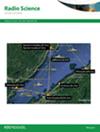An assessment of HF radio wave propagation in antarctica for a radio link between McMurdo and south pole station
IF 1.6
4区 地球科学
Q3 ASTRONOMY & ASTROPHYSICS
引用次数: 0
Abstract
In this work, we analyze data collected by an HF transmitter/receiver radio link, operating as an oblique ionosonde between the McMurdo Station (transmitter) and South Pole Station (receiver) at 4.1, 5.1, 6.0, 6.4, and 7.2 MHz between 28 February and 14 March 2019. To help contextualize the link's data we have performed numerical raytrace simulations to help understand the observations. By considering both the data and simulations, we have identified both single- and two-hop E- and F-region propagation modes in the data, where the multi-hop modes were observed in the hours around sunrise and sunset in the 4.1 and 5.1 MHz channels. This is an unexpected result given the accepted wisdom that multi-hop modes, which require a ground scatter component, cannot be supported in Antarctica because of the highly absorptive ice covering much of the continent. Our results show that multi-hop propagation modes can be supported in the region under specific ionospheric conditions—around sunrise and sunset—if the mode's ground scatter component is collocated with the Transantarctic Mountains. The mountains are located along the great-circle path between the link's transmitter and receiver. However, the combination of favorable ionospheric and ground scattering conditions makes the detection of the multi-hop mode a rare occurrence in the data set analyzed here. These findings are critical to data analysis efforts of any current or future oblique ionosonde systems operating in Antarctica and other regions such as the Arctic.南极洲高频无线电波传播评估,用于麦克默多和南极站之间的无线电链路
在这项工作中,我们分析了高频发射机/接收机无线电链路收集到的数据,该链路在麦克默多站(发射机)和南极站(接收机)之间作为斜电离层探测仪运行,频率为 4.1、5.1、6.0、6.4 和 7.2 MHz,时间跨度为 2019 年 2 月 28 日至 3 月 14 日。为了帮助理解链路数据的来龙去脉,我们进行了数值光线跟踪模拟,以帮助理解观测结果。通过同时考虑数据和模拟,我们确定了数据中的单跳和双跳 E- 和 F- 区域传播模式,其中多跳模式在日出和日落前后的几个小时内在 4.1 和 5.1 MHz 信道中被观测到。这是一个意想不到的结果,因为人们普遍认为,多跳模式需要地面散射成分,而南极洲大部分地区都覆盖着高吸收性冰层,因此无法支持多跳模式。我们的研究结果表明,在特定的电离层条件下--日出日落前后--如果模式的地面散射分量与横贯南极山脉相匹配,多跳传播模式就能在该地区得到支持。山脉位于链路发射器和接收器之间的大圆路径上。然而,有利的电离层和地面散射条件相结合,使得多跳模式的探测在本文分析的数据集中很少发生。这些发现对于当前或未来在南极和北极等其他地区运行的任何斜电离层探测仪系统的数据分析工作至关重要。
本文章由计算机程序翻译,如有差异,请以英文原文为准。
求助全文
约1分钟内获得全文
求助全文
来源期刊

Radio Science
工程技术-地球化学与地球物理
CiteScore
3.30
自引率
12.50%
发文量
112
审稿时长
1 months
期刊介绍:
Radio Science (RDS) publishes original scientific contributions on radio-frequency electromagnetic-propagation and its applications. Contributions covering measurement, modelling, prediction and forecasting techniques pertinent to fields and waves - including antennas, signals and systems, the terrestrial and space environment and radio propagation problems in radio astronomy - are welcome. Contributions may address propagation through, interaction with, and remote sensing of structures, geophysical media, plasmas, and materials, as well as the application of radio frequency electromagnetic techniques to remote sensing of the Earth and other bodies in the solar system.
 求助内容:
求助内容: 应助结果提醒方式:
应助结果提醒方式:


